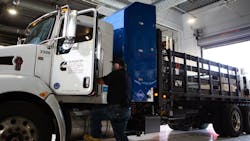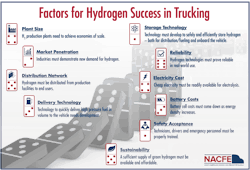Hydrogen’s future in trucking has steep hill to climb
Of course, there are questions when looking to adopt a new technology—and it's no different when it comes to hydrogen fuel-cell electric vehicles (FCEVs). How do I fuel the vehicle? Where are the fueling stations? Do I need to buy both the vehicle and a fueling station?
The hub-and-spoke duty cycle, where trucks return to base each day, is gaining in viability for FCEVs, noted Wido Westbroek, senior director of fuel-cell strategic projects for Cummins, “and so, you’re not looking at the long-distance haulers where they need to have fueling along the road.”
In this scenario, an FCEV with a range of 500 miles would not need to rely on a public hydrogen fueling infrastructure station but rather would fuel up at home base. A fleet would need several FCEVs to justify installing their own fueling infrastructure, though, Westbroek added.
See also: The dawn of hydrogen trucks
And installing those hydrogen fueling stations at scale will remain a major hurdle. According to the latest U.S. Department of Energy data, California has seven heavy-duty fueling stations, with two more planned. The light-duty space has far more options, with 54 open and 34 planned.
“The other big barrier, of course, is cost,” Westbroek said of what is preventing more heavy-duty hydrogen infrastructure. “Whenever anything starts, the first few, the first 100, even the first 1,000, are way more expensive than when you have tens of thousands, or hundreds of thousands.”
“The costs of hydrogen, vehicles, and hydrogen production all must come down significantly to make hydrogen economically competitive with alternatives,” noted Mike Roeth, executive director of the North American Council for Freight Efficiency, which released a detailed confidence report on the viability of FCEVs. After speaking with industry experts and researchers, Roeth surmised that “these costs will be reduced through scale and innovation over time.”What makes the uphill climb even steeper is that diesel, already proven and with bountiful infrastructure, provides a cost advantage for fleets, which operate on slim margins as it is.
“There has to be funding available, enough interest, enough support, whether it’s within the company itself, or whether they’re getting outside support from government agencies, to lower that hurdle to get those first trucks out on the road,” Westbroek said.
It is only once the fueling infrastructure and the cost come together that mass adoption will take place and FCEVs can be on the road at scale.
“There is a real recognition that this is no longer a hype cycle that we’re in,” Westbroek proclaimed. “There is now a real urgent need, a strong sense of what we call ‘winds at our back,’ whether it be government agencies talking it up, whether it’s politicians that are seeing the need to adopt and move this forward—everyone is starting to see that we are not talking about the next one, or two, or three years; we are seeing it over the next three to 10 years that this is an ever-rising curve.
“The urgency is not just to continue to move the cost down to lower that barrier, but also there is urgency to lay the foundation of knowledge within the operations people, the maintenance people, all those other skill sets that have to participate in ensuring that it is a success when it’s on the road. That is also now part of our work,” he reinforced. “And there is a lot of work that needs to be done to help people understand how to maintain, how to support the vehicle once it is on the road… Success doesn’t end with the delivery of the truck. It is it really that full lifecycle.”
And though it may seem as if the industry is at the tip of the diving board, it may be time to take the plunge into the next zero-emission solution.
This article originally appeared on Fleet Maintenance, FleetOwner's sister publication and part of the Endeavor Commercial Vehicle Group.
About the Author
Tyler Fussner
Assistant Editor | Vehicle Repair Group
Tyler Fussner is a former assistant editor for Endeavor Business Media's Commercial Vehicle Group, including FleetOwner and Fleet Maintenance.

